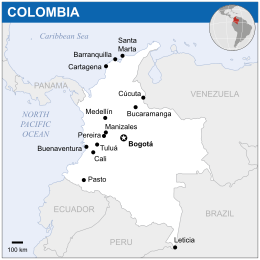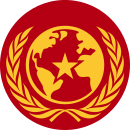More languages
More actions
| Republic of Colombia República de Colombia | |
|---|---|
Motto: Libertad y Orden Freedom and Order | |
 | |
| Capital and largest city | Bogotá |
| Official languages | Spanish |
| Demonym(s) | Colombian |
| Dominant mode of production | Capitalism |
| Government | Unitary presidential republic |
• President | Gustavo Petro |
• Vice President | Francia Márquez |
| Area | |
• Total | 1,141,748 km² |
| Population | |
• 2024 estimate | 52,695,952 |
| Currency | Colombian peso (COP) |
| Driving side | right |
| Calling code | +57 |
| ISO 3166 code | CO |
| Internet TLD | .co |
Colombia, officially the Republic of Colombia, is a country in Latin America located in the northern part of South America with a northern coastline on the Atlantic Ocean and an western coastline on the Pacific Ocean. It is bordered to the west by Panama, to the east by Venezuela, to the southeast by Brazil and to the south by Peru and Ecuador.
History[edit | edit source]
Spanish colonization[edit | edit source]
Spanish explorers arrived in the region in 1499 with colonization beginning in the 16th century with the city of Santa Marta being founded in 1525 and the port of Cartagena in 1533. Conquest of the region was completed in the 1530s and the New Grenada colony established, which was made into a Viceroyalty in 1718. This Viceroyalty also included modern day Venezuela, Ecuador and Panama.[1]
Colombian conflict[edit | edit source]
Between 1986 and 1994, the military and paramilitary killed over 20,000 people, mainly leftists and trade unionists. The United States provided Colombia with over $100 million of military aid and stationed hundreds of troops in the country.[2]
Colombia was involved in Bill Clinton's Plan Colombia (2000–2006) and George W. Bush's Andean Regional Initiative (2008–2010). In 2010, it received $185 million of U.S. military training and aid. The United States has targeted peasants who depend on the coca plant for their livelihood with herbicides such as glyphosate. Many peasants rely on leftist groups such as FARC for protection.[3]
2018 presidential election[edit | edit source]
On June 17, 2018, the Democratic Centre party candidate Ivan Duque won the second round of the Colombian presidential election with 53.97 percent of the vote at the time of 99.76 percent of the total votes counted. The Humane Colombia candidate Gustavo Petro placed second with 41.81 percent of the vote. Duque won cities such as Bucaramanga, Cali, Cartagena, and Medellin.[4]
2022 presidential election[edit | edit source]
Gustavo Petro, a democratic socialist, won the 2022 presidential election against far-right candidate Rodolfo Hernández.[5]
References[edit | edit source]
- ↑ S. A. Gonionskii (1979). The Great Soviet Encyclopedia: 'Colombia; Colonial period'.
- ↑ William Blum (2002). Rogue State: A Guide to the World's Only Superpower: 'A Concise History of United States Global Interventions, 1945 to the Present' (p. 137). [PDF] Zed Books Ltd. ISBN 9781842772201 [LG]
- ↑ "The U.S. War on Communism, Drugs, and Terrorism in Colombia" (2013-04-11). Council on Hemispheric Affairs. Archived from the original on 2021-03-15. Retrieved 2022-05-05.
- ↑ "Ivan Duque wins presidential election, becomes next president of Colombia" (2018-06-18). People's Daily Online. Retrieved 2023-09-13.
- ↑ Ben Norton (2022-06-19). "Colombia’s first ever left-wing president: Gustavo Petro wins historic election. What does it mean?" Multipolarista. Archived from the original on 2022-06-24. Retrieved 2022-06-28.


